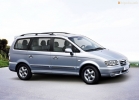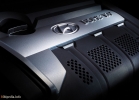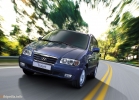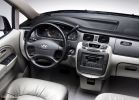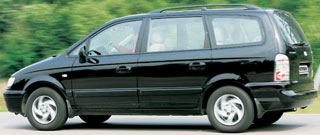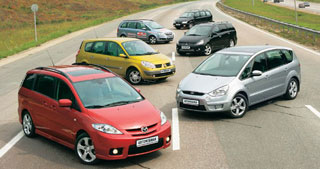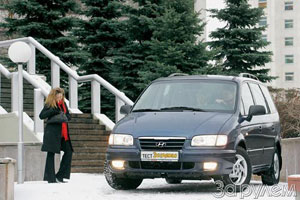Test Drive Hyundai Trajet since 2004 Minivan
His way
Having resulted in copying outdated Japanese models, Hyundai Motor Company finally went to his own way. And unsuccessfully. Created by Koreans Minivan Trajet is quite competitive.On the brave pitch of the Koreans, not only thrust for self-expression. The rapidly growing popularity of multipurpose vehicles (MPV) promises manufacturers of such cars considerable profits. True, you first need to invest and forces. For two and a half years, $ 300 million was driven by the Hyundai Motor Company in the code name FO. But what is the result! With such a minivan, it is not ashamed to enter the market of creepy Europe.
By the way, Trajet that translated from French means the path, the journey, was created specifically for Europeans. Therefore, the design studio Hyundai in Germany received the engineering on the development of the car. When the basic eurocalone model approved the management of the company, the final convection of Trajet was instructed by the Design Bureau Hyundais Namyang R & D Center in Korea, where an experienced sample of minivan was subsequently created.
As public opinion polls in Europe, Hyundai Trajet potential buyers highly appreciated its stylish, in the spirit of a passenger car, outlines. No wonder the appearance of Trajet is characterized by the clean and elegant simplicity that the majority understands and takes. Healthy conservatism in modern cut the essence of the architecture of Korean minivan.
Trajet creators made the car as comfortable as possible, comfortable and practical. Compact minivan size (length 4695, width 1840, wheelbase 2830 mm) on lively European roads among their own. It is easy to park, on it (getting used to an invisible nose) it is easy to maneuver on narrow winding streets.
Hyundai Trajet is available in two GL trim and more rich GLS. The car is richly equipped even in the basic performance. At your service a huge amount of diverse additional equipment, for example, rotating 180 front armchairs or rain sensor, automatically including wipers.
Inside Trajet is as pleasant as convenient, in a small exception. Spaces in the cabin are more than enough for all seven passengers. Five rear seats allow you to work the wonders of transformation. That's just labor costs it requires considerable: the seats are heavy, and the mechanism of their attachment from the first time is not easy to master.
When you sit behind the steering wheel, you realize that the upcoming trip will succeed a lot of positive emotions. Milestly externally, the front panel from an ergonomic point of view is planned perfectly. The number of buttons electrifying the burdensome (such as opening windows) and distracting processes from control, corresponds to the traditional Korean generosity on this account.
As a standard power plant on Hyundai Trajet, a 2-liter 136-strong Sirius gasoline engine is used. He proven himself well on other models of the company, besides, it was recently modernized, so that noise and vibrations in the Trajet salon are minimized.
The engine provides a trouble-free start, overclocking the car up to 100 km / h for 13.1 s, saves gasoline (by the way, 92th), spending an average of 9 liters per 100 km. Working the power unit is measured, without much enthusiasm. However, where the ward is to take, if the cutting mass of the minivan exceeds 1700 kg. Involuntarily there are concerns that the full load will turn the car into a sleepy fly.
It seems that this circumstance was calculated. After all, for the traveler, winding kilometers of the motorway, the engine power is enough. And the use of Trajet as an office car in most cases is not related to the transportation of weights. Nevertheless, the TRAJET also provides for a 2.7-liter V6 DELTA motor, fully appropriate to peak operating conditions. By the way, it is equipped with only a 4-speed automatic transmission.
On our same trajet installed a 5-speed mechanical KP (the machine is mounted here on request). Thanks to the new synchronization mechanism, it is minimized in size. Switching is so easy that it is difficult to talk about the informativeness of the lever. Translation from Trajet is long, and this is no doubt valuable quality.
Steering is beyond praise. This balanced wheel for light vehicles uncommon. Brake confidently slow running machine with disk mechanisms and ABS. McPherson suspension in front and semi-independent rear beam pleases developed the ability to extinguish the vibrations from road imperfections. Under the weight of the suspension is too soft, and the car, respectively, over rolls in cornering, but bright-eyed with heavy baggage on board is unreasonable in principle.
For a minivan, and even in a rich configuration, Trajet is inexpensive for all about all of $ 21998. How did you notice, even those who belong to the Korean cars with prejudice experienced Hyundai Trajet in fact, declare: And I like it! This writer among them.
Specifications Hyundai Trajet 2.0M / T GLS
Body tselnometal., 5-door
The number of places, persons. 7.
Curb Weight, kg 1729
Gross vehicle weight, kg 2400
Dimensions (length / width / height) mm 4695/1840/1710
Base, mm 2830
Ground clearance, mm 158
Maximum speed km / h 179
Acceleration to 100 km / hr, with 13.1
Fuel control, l / 100 km:
- urban 12.9
- extra-urban 7.2
- Mixed cycle 9.3
Engine:
- the type of gasoline, in-line, 4-cylinder, 16-valve
- working volume 1997 cm3
- Power, hp at min-1 136/5800
- torque Nm at min-1 183/4600
- the power supply system multi-point injection
Transmission mech., 5-speed, front-wheel drive
Tire size 215 / 65R15
Suspension McPherson-type wheel
brakes:
- front disc, ventilated
- rear drum
Steering Pinion with booster
Fuel tank, 65 l
Price, $ 21998
Text: Igor Kuznetsov
A source: Magazine 5 Wheel [10/2000]

